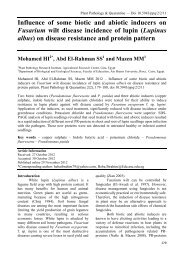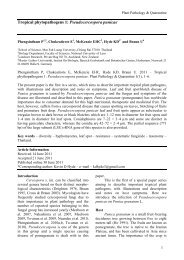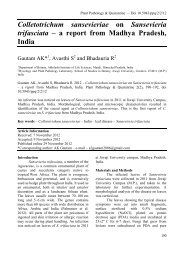Genus Cercospora in Thailand: Taxonomy and Phylogeny (with a ...
Genus Cercospora in Thailand: Taxonomy and Phylogeny (with a ...
Genus Cercospora in Thailand: Taxonomy and Phylogeny (with a ...
You also want an ePaper? Increase the reach of your titles
YUMPU automatically turns print PDFs into web optimized ePapers that Google loves.
Pseudocercospora based on ITS region of<br />
partial rDNA sequence analysis, <strong>and</strong> reaffirmed<br />
that Ramulispora Miura <strong>and</strong> Mycocentrospora<br />
Deighton are not related to Mycosphaerella<br />
teleomorph. Stewart et al. (1999) also reduced<br />
Paracercospora Deighton to a synonym of<br />
Pseudocercospora. However, because of limited<br />
taxa, no other species l<strong>in</strong>ked to Mycosphaerella<br />
teleomorph were <strong>in</strong>cluded <strong>in</strong> their<br />
analysis, <strong>and</strong> it was not possible to determ<strong>in</strong>e<br />
the phylogenetic relationship of the <strong>Cercospora</strong><br />
species to other anamorphs genera.<br />
Similar to the anamorphic state, the<br />
taxonomy <strong>and</strong> phylogenetic of Mycosphaerella<br />
(teleomorphic state) is also complicated (von<br />
Arx 1983, Crous et al. 2000). Due to the large<br />
number of associated anamorphs, Crous &<br />
W<strong>in</strong>gfield (1996) noted that Mycosphaerella<br />
was a polyphyletic assemblage of presumably<br />
monophyletic anamorphic genera. Goodw<strong>in</strong> et<br />
al. (2001), based on the analysis of a large<br />
number of anamorphs of Mycosphaerella us<strong>in</strong>g<br />
ITS region of rDNA sequence, also found that<br />
Mycosphaerella was not monophyletic. However,<br />
Goodw<strong>in</strong> et al. (2001) noted that <strong>Cercospora</strong><br />
s. str. formed a highly supported monophyletic<br />
group, <strong>and</strong> the <strong>Cercospora</strong> species<br />
that produced the tox<strong>in</strong> cercospor<strong>in</strong> were suggested<br />
to have a s<strong>in</strong>gle evolutionary orig<strong>in</strong>.<br />
Crous et al. (2007), based on the analysis of<br />
Large Sub Unit (LSU) region of ribosomal<br />
DNA (28SrDNA), reaffirmed that Mycosphaerella<br />
was polyphyletic.<br />
Although the Mycosphaerella complex<br />
encompasses thous<strong>and</strong>s of names, studies on<br />
the phylogenetic relationship among taxa <strong>in</strong><br />
this group are still rare compared <strong>with</strong> other<br />
fungal groups. This is probably due to the fact<br />
that these organisms are relatively difficult to<br />
isolate on artificial medium (Crous et al. 2007).<br />
In fact, most taxa belong<strong>in</strong>g to Mycosphaerella<br />
<strong>and</strong> anamorphs (the cercosporoid fungi) which<br />
are seen successfully cultivated on the artificial<br />
medium grow relatively slower than other<br />
fungi.<br />
<strong>Phylogeny</strong> of <strong>Cercospora</strong> Species from<br />
<strong>Thail<strong>and</strong></strong><br />
A phylogenetic tree of 42 representative<br />
sequences of <strong>Cercospora</strong> <strong>and</strong> allied genera<br />
from <strong>Thail<strong>and</strong></strong> <strong>and</strong> other sequences obta<strong>in</strong>ed<br />
from NCBI (National Center for Biotechnology<br />
Plant Pathology & Quarant<strong>in</strong>e<br />
Information) GenBank database, obta<strong>in</strong>ed from<br />
unweighted maximum parsimony (UMP) analysis<br />
method are shown <strong>in</strong> Fig. 7.<br />
Based on this analysis, 6 genera of the<br />
cercosporoid fungi <strong>in</strong>cluded <strong>in</strong> the analysis,<br />
namely, <strong>Cercospora</strong>, Septoria, Pseudocercospora,<br />
Stigm<strong>in</strong>a, Ramularia <strong>and</strong> Passalora<br />
appear as monophyletic groups <strong>with</strong> 60%, 53%,<br />
95%, 100%, 100% <strong>and</strong> 79% bootstrap support,<br />
respectively (Fig. 7). Cladosporium was used<br />
as an out group. This result shows that morphological<br />
def<strong>in</strong>itions of all these genera are also<br />
well-def<strong>in</strong>ed phylogenetically. A similar f<strong>in</strong>d<strong>in</strong>g<br />
was also reported by Crous et al. (2001)<br />
<strong>with</strong> the exception of genus Stigm<strong>in</strong>a. The<br />
general morphological characteristics among<br />
these six genera <strong>and</strong> other cercosporoid fungi<br />
are also briefly illustrated <strong>in</strong> Fig. 7. This<br />
diagram shows the differences among taxa<br />
<strong>with</strong><strong>in</strong> cercosporoid fungi which are ma<strong>in</strong>ly<br />
separated by dist<strong>in</strong>ct structures of conidia,<br />
conidiophores, conidiogenous cells, hila <strong>and</strong><br />
scars.<br />
The <strong>Cercospora</strong> species formed a monophyletic<br />
clade <strong>with</strong> 60% bootstrap support (Fig.<br />
7). This clade appeared as a sister group to<br />
Septoria clade <strong>with</strong> 89% bootstrap support<br />
which <strong>in</strong>dicates a close relationship between<br />
the two genera. Septoria, a coelomycetous<br />
fungus, shares similar morphology characteristics<br />
to <strong>Cercospora</strong> <strong>in</strong> hav<strong>in</strong>g holoblastic<br />
<strong>and</strong> sympodial conidiophore proliferation, as<br />
well as hyal<strong>in</strong>e, filiform to acicular <strong>and</strong><br />
multiseptate conidia (Sutton 1980). However,<br />
the two genera are morphologically separated<br />
due to Septoria produc<strong>in</strong>g pycnidial conidiomata<br />
(Figs 7–8). These genera are ma<strong>in</strong>ta<strong>in</strong>ed<br />
as separate taxa, although Verkley & Star<strong>in</strong>k-<br />
Willemse (2004) noted that conidiomatal structure<br />
seems to have little predictive value for<br />
phylogenetic relatedness, but phylogenetically<br />
analysis showed that <strong>Cercospora</strong> <strong>and</strong> Septoria<br />
are not monophyletic <strong>with</strong><strong>in</strong> Mycosphaerella<br />
<strong>and</strong> its anamorphs. It was probably because of<br />
The presence of <strong>in</strong>termediate species between<br />
<strong>Cercospora</strong> <strong>and</strong> Septoria, therefore, more<br />
genes loci or taxa are required to analyze the<br />
relationship between the two genera.<br />
Passalora clade appeared as a basal<br />
group <strong>in</strong> the phylogenetic tree <strong>with</strong> 79% bootstrap<br />
support. This genus was <strong>in</strong>troduced by<br />
Fries (1849) <strong>with</strong> Passalora bacilligera (Mont.<br />
21









